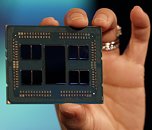Tuesday, November 6th 2018

AMD Zen 2 "Rome" MCM Pictured Up Close
Here is the clearest picture of AMD "Rome," codename for the company's next-generation EPYC socket SP3r2 processor, which is a multi-chip module of 9 chiplets (up from four). While first-generation EPYC MCMs (and Ryzen Threadripper) were essentially "4P-on-a-stick," the new "Rome" MCM takes the concept further, by introducing a new centralized uncore component called the I/O die. Up to eight 7 nm "Zen 2" CPU dies surround this large 14 nm die, and connect to it via substrate, using InfinityFabric, without needing a silicon interposer. Each CPU chiplet features 8 cores, and hence we have 64 cores in total.
The CPU dies themselves are significantly smaller than current-generation "Zeppelin" dies, although looking at their size, we're not sure if they're packing disabled integrated memory controllers or PCIe roots anymore. While the transition to 7 nm can be expected to significantly reduce die size, groups of two dies appear to be making up the die-area of a single "Zeppelin." It's possible that the CPU chiplets in "Rome" physically lack an integrated northbridge and southbridge, and only feature a broad InfinityFabric interface. The I/O die handles memory, PCIe, and southbridge functions, featuring an 8-channel DDR4 memory interface that's as monolithic as Intel's implementations, a PCI-Express gen 4.0 root-complex, and other I/O.
Source:
Tom's Hardware
The CPU dies themselves are significantly smaller than current-generation "Zeppelin" dies, although looking at their size, we're not sure if they're packing disabled integrated memory controllers or PCIe roots anymore. While the transition to 7 nm can be expected to significantly reduce die size, groups of two dies appear to be making up the die-area of a single "Zeppelin." It's possible that the CPU chiplets in "Rome" physically lack an integrated northbridge and southbridge, and only feature a broad InfinityFabric interface. The I/O die handles memory, PCIe, and southbridge functions, featuring an 8-channel DDR4 memory interface that's as monolithic as Intel's implementations, a PCI-Express gen 4.0 root-complex, and other I/O.

71 Comments on AMD Zen 2 "Rome" MCM Pictured Up Close
Just wondering.
Of course it's entirely possible that we get a single CCX with 4 cores, to rule them all.
I'm quite excited to see Zen 2.
Now that they have taken all I/O out of the zen dice (yes, i too say "dice", seems sensible), they can change the former strategy of having 2 designs: one die with 1 CCX and an iGPU for the Raven Ridge line, and another with 2 CCXs for everything else. Now they could have several chiplets connected via IF2 on the same substrate to serve different markets. So for example 1 Zen 2 die + I/O + iGPU for Picasso, 2 zen 2 dice + I/O for regular Ryzen 3xxx (no iGP), 4 zen 2 dice + I/O for Threadripper 3, and as seen yesterday 8 dice + I/O for Epyc 2. Only the I/O would have to change from one design to another, and not even, they might be able to just use two versions of the I/O die, one for TR & Epyc, one for Ryzen 3xxx (both Picasso and regular Ryzen).
In any case, i think an 8 cores CCX is out of question, out of pure complexity of the design. We'll see soon enough!
Assuming they don't fall on their faces at launch, and this is AMD so that can't be ruled out, this looks like a very promising technology.
If they added as much as 32(?) MB L3 then the CCX will have to be redesigned, it's entirely plausible that the same core layout was reused but there are other major changes as well which we'll find out about eventually.
Read the following:
NoC Architectures for Silicon Interposer Systems (PDF file) for context, and Enabling Interposer-based Disintegration of Multi-core Processors (PDF file).
Both of these require an interposer so dunno exactly how they do it. Perhaps this will come only with Zen 3? Dunno.
(www.anandtech.com/show/11170/the-amd-zen-and-ryzen-7-review-a-deep-dive-on-1800x-1700x-and-1700/5)
See, in a 4 cores CCX there have to be 6 links between the cores, between their caches, actually, so that each cache can transfer data to and from every other core. As you add cores, the number of links grows as i indicated, just make the diagram with 5 cores and you will see.
www.anandtech.com/show/11170/the-amd-zen-and-ryzen-7-review-a-deep-dive-on-1800x-1700x-and-1700/5